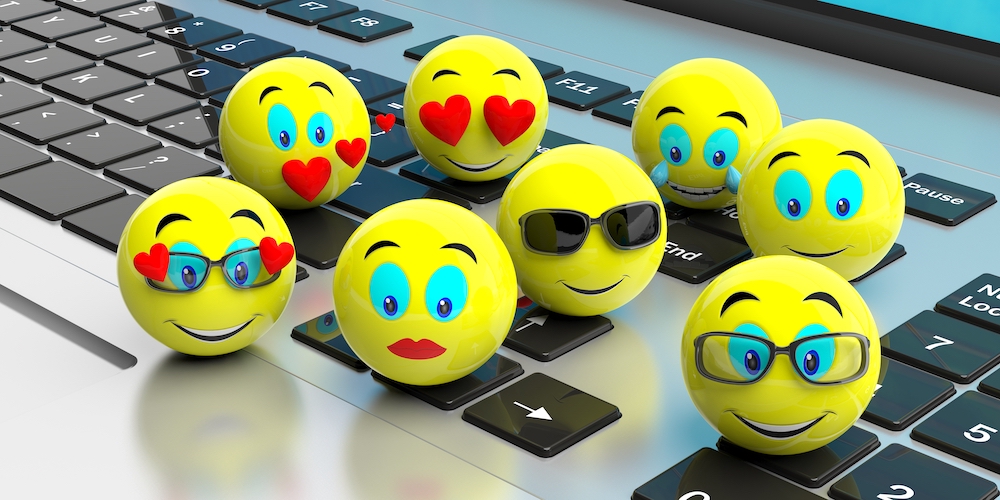Tuesday, October 18, 2022
 Image: DepositPhoto
Image: DepositPhotoEver since writing a book about business emails last year, I’ve increased my use of emojis. I sprinkle them into LinkedIn messages, texts, emails—even blog posts! ??
A new Adobe study suggests that I’m not alone, and it’s not only in personal messages.
Of the 5,000 US-based emoji users surveyed, more than half have increased their use of emojis at work in the past year. Perhaps with less face-to-face interactions, we need more ways to make ourselves emotionally present with others.
The business case for emojis
According to the Adobe study, emoji use has grown far beyond personal texts. The research reveals compelling for using them in work-related communications.
These are a few of the reported benefits (with the percentage of users citing them) for using emojis on the job:
- Strong feeling of connection to teams (63%)
- Sharing ideas quickly (79%)
- Fostering creativity (58%)
Here’s a surprise: more than half of the respondents are more receptive to taking on a task if the request included an emoji! (Next time you want to ask someone to review a document, add an emoji to the request!)
We write to communicate both ideas and tone, and to connect with our readers. Those tiny graphics, used wisely and with restraint, help us achieve those goals.
Emojis make your tone visible
Most of us are terrible at interpreting tone in written communications like email. The shorter the message, the more likely we are to mis-read it.
And when we’re under stress, we’re more likely to interpret things through a negative, stress-induced filter.
Emojis to the rescue!
The Adobe study shows that the most popular emojis in the US are:
??, ??, ??, ??, ??
They signal things like, “You’re funny,” or “great point” or “that’s sad.” They extend support, encouragement, and empathy in much less space than it would take to do with words.
Strengthening human connection with emojis
A majority of U.S. emoji users (88%) report they are more likely to feel empathetic toward someone if they use an emoji.
Future of Creativity Report by Adobe
That’s fascinating! Introducing small emotional cues into our writing appears to trigger more empathy from the reader.
And here’s another benefit in a world of remote work: many in the Millennial and Gen Z generations say that emojis make them feel more connected to colleagues they have yet to meet in person.
Why would we neglect technology that helps us connect with others and clarifies our tone?
Advice for the emoji-resistant
Try an experiment this week. Start adding one or two emojis to emails and social media posts.
Choose safe, well-known symbols to avoid misunderstanding. If you’re using them to communicate emotion, choose straightforward emotions rather than nuanced ones. (See that list of favorites above.)
And make sure the emoji echoes the tone of the words themselves.
How does it feel? Does clicking the smiling face make you smile yourself?
I sometimes find that using emojis lifts my own emotions. Might it have the same effect on the recipient?
Advice for emoji enthusiasts
The Adobe research gives you data to back up your use for the doubters. But it also highlights areas of caution.
The report notes that about half of the people surveyed in the U.S. use emojis for meanings other than their intended meaning. So, as with your words, be clear.
First, remember emoji use varies with generations, context, and even geographic areas. Consider your recipient’s context, and whether they will understand what you’re writing.
Some people may struggle to decipher them on their phones, much less understand what you’re trying to say. You don’t want people to feel like they’re missing a joke or squinting at a screen to decipher your meaning.
A long string of emojis can be daunting. If your reader uses text-to-speech translation, they’ll have to listen to all the descriptions—and they will not thank you for that. ??
Make sure the emojis support, rather than replace, the words. They are illustrations of tone and support, not the vehicle for content.
Related content
Find the Adobe study here: The Future of Creativity: 2022 U.S. Emoji Trend Report
For an excellent book on digital communications, read Digital Body Language by Erica Dhawan.
Cuesta Park Consulting & Publishing publishes books and online courses for writers and marketing professionals. Books are available in print, ebook, and audiobook formats from a wide range of retailers. For more information, visit AnneJanzer.com.